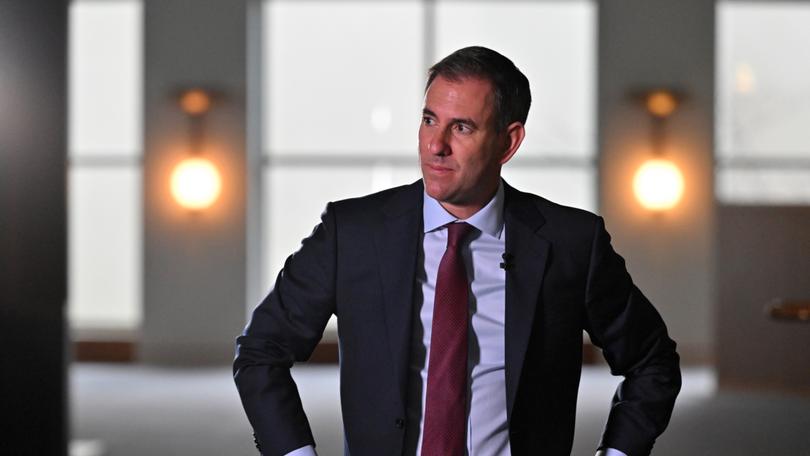Federal Budget 2024: Jim Chalmers offers ambitious plans in his Budget of two parts

Jim Chalmers has unveiled a Budget of two parts that offers $7.8 billion more right now to help out with power bills, the cost of medicines and rent and has an eye to establishing Australia as a clean energy powerhouse.
But the Treasurer has also handed down a set of books with $122.1 billion in deficits over the next four years, sluggish economic growth and ambitious inflation projections.
The Budget contains cost-of-living relief including tax cuts, power bill rebates and a freeze on medicine prices, along with a large package aimed at kickstarting clean energy industries such as critical minerals processing and green hydrogen.
Sign up to The Nightly's newsletters.
Get the first look at the digital newspaper, curated daily stories and breaking headlines delivered to your inbox.
By continuing you agree to our Terms and Privacy Policy.There are also billions of dollars for housing and health and a push to get thousands of more people into university or vocational education.
The Budget is not tipped to return to balance until 2034-35 despite Dr Chalmers’ insistence the Government had shown a willingness “to chip away at this problem over time”.
The $9.3 billion surplus for 2023-24 was not an end in itself but a move to put downward pressure on inflation, he said.
Inflation is forecast to fall within the Reserve Bank’s target range by the end of 2024 and soften further to 2.5 per cent by 2026-27.
This is almost a year earlier than the RBA forecast last week.
However, the Budget papers note that inflation “could prove more persistent than forecast”, especially if productivity does not pick up as expected.
There is also significant uncertainty over whether household spending will rebound as disposable income increases or whether people will instead seek to rebuild their savings.
On top of the tax cuts for 13.6 million people, every household will get $300 off their power bills over the next year starting from July while a million small businesses will receive $375 rebates, in a $3.5 billion package.
While last year’s rebates were targeted only to low-income households, these will go to everyone – and West Australians will get even more with the State Government adding in $400.
“It’s really just recognition that these cost-of-living pressures don’t end with people who are on pensions and payments. They’re a big priority for us, but (we are) recognising that people are doing it tough up and down the income scale and trying to provide as much relief as we responsibly can,” Dr Chalmers told The West Australian.
The Government is also boosting Commonwealth rent assistance payments by 10 per cent, the second year in a row it has increased, at a cost of $1.9 billion.
Treasury says the two measures combined will directly reduce inflation by half a percentage point.
“We are very confident that the composition of that spending next year is going to be helpful in the fight against inflation rather than harmful in the fight against inflation,” Dr Chalmers said.
“We’re not spraying around big cheques to people, we are putting downward pressure on two of the most important bills that they have, rent and electricity, and … doing that in ways that are not creating problems elsewhere in the economy.”
The maximum cost of prescriptions on the PBS will be frozen at $31.60 for the next year, and at $7.70 for five years for pensioners and concession card holders. The Government will also open another 29 bulk-billing Medicare urgent care clinics.
Opposition Leader Peter Dutton described it as a “magic pudding exercise” from the Treasurer.
“Somehow, his assumptions are better than the Reserve Bank’s – I mean, nobody believes that,” Mr Dutton told Coalition colleagues meeting in Canberra, to laughter.
In the back half of the Budget there is a switch to focus on boosting growth, primarily through the Future Made in Australia package and an increased push to get thousands more people into university or vocational education.
The Government is leaning heavily on the tax system to incentivise investment, with new production tax credits for critical minerals processing and green hydrogen worth almost $32 billion over the next 14 years.
There is also money to speed up environmental, planning, cultural heritage and foreign investment approvals, and for better community engagement in an acknowledgement that some feel railroaded by renewables projects and new transmission lines.
Dr Chalmers said the overall Budget offered “a really ambitious growth agenda for the future” that would make the country and Australians more prosperous.
Economic growth is forecast to be significantly slower in current financial year — 1.75 per cent — followed by 2 per cent in 2024-25 and slowly increasing by a quarter of a percentage point in each subsequent year.
The Budget cautions that Australia is not immune from international pressures, with global growth expected to be flat for the next three years, the longest stretch of below-average growth since the early 1990s.
But it says continuing job growth, stronger wage growth and the tax cuts should give households more disposable income in real terms.
Although job numbers are tipped to grow at 2.25 per cent for 2023-24, this is forecast to drop to just 0.75 per cent in the next financial year.
However, while unemployment is expected to tick up slightly to 4.5 per cent in 2024-25, the Budget forecasts it will stay at that level rather than worsen further.
Dr Chalmers has posted a $9.3 billion surplus for the financial year that ends in June – a $23.2 billion turnaround from what was forecast last year.
But his bottom line falls back into deficit with the 2024-25 Budget $28.3 billion in the red.
This deteriorates further to a $42.8 billion deficit in 2025-26 – more than $6 billion worse than forecast a year ago – then $26.7 billion in 2026-27 and $24.3 billion in 2027-28.
But Dr Chalmers said the decision to return almost all the windfall revenue to the Budget coffers has wiped $183 billion off gross debt compared with pre-election decisions.
The debt will still go past $1 trillion in 2025-26 and increase in the forward estimates.

